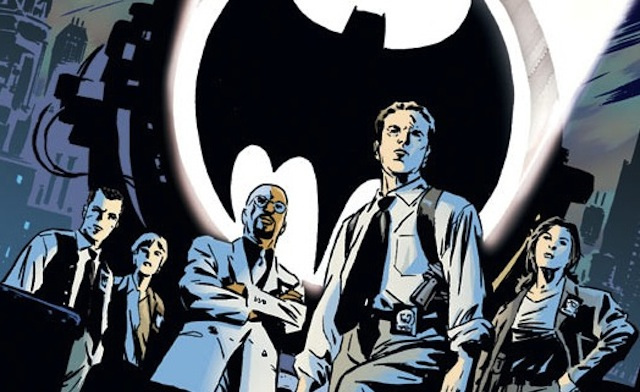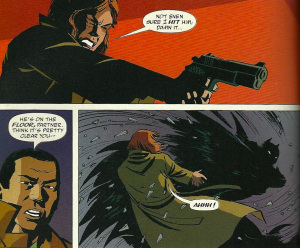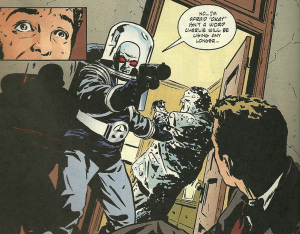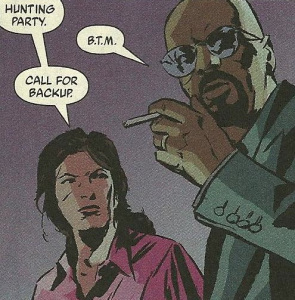The badges behind the bat

One of the best things to come out of Batman: The Animated Series—and there were a number of great things that came out of Batman: The Animated Series—was the character of Renee Montoya. As a uniformed patrolwoman, Montoya starts off as the smart, straight-laced junior foil to the self-serving, corner-cutting, Batman-hating Detective Harvey Bullock. They’re both good cops in the end, but while Bullock will lie to cover his own ass and resents Batman for making him look ineffective, Montoya is honest, honorable, and knows that Batman is the same. When the series got a redesign, Montoya got a promotion to detective, and was partnered with Bullock. The comics, on the other hand, didn’t have much use for Montoya as a uniform, so DC made her a detective and partnered her with Bullock in her very first appearance. She’s put to great use in the extended “No Man’s Land” storyline, but really comes into her own when the Gotham City Police Department is given its chance to shine in the short-lived but absolutely wonderful Gotham Central.
Gotham Central ran from 2003 to 2006, and Ed Brubaker and Greg Rucka traded off storylines for the entirety of that run. While Gotham Central‘s fan base was (and is) avid, it was never large, which is something of a crime. The writing and art in Gotham Central are pitch-perfect. The characters are put-upon, overworked, and worst of all in a city like Gotham, honest. Brubaker and Rucka did a difficult thing in an extraordinary way by telling stories that seem exactly the right size in a normally hyper-colored, overexcited universe. (Check out the Teen Titans cameo in the “Dead Robin” storyline. It’s perfectly done.) If you’re the sort of person who claims to love Batman stories because of the human dimension—where Batman is just a man pushed to do incredible things at the edge of human (and not superhuman) ability—then Gotham Central will either give you what you never realized you had always been looking for, or it will call you out as a liar. The Batman is the superhuman presence in these pages, always a force for good, but not always on the cops’ side, as they are well aware.

Batman in action
On a side note, the series really do a good job of portraying that darkness as something the Batman himself does. There’s a scene in a later issue where a detective accidentally shoots Batman, and when he’s laying unconscious on the floor, he’s just a man in a belt and a cape. As you can see, he gets better.
Death is a troublesome thing in mainstream comic books, and Gotham Central‘s treatment of death is one of the best measures of the title’s success. As much as comic books would like to tell you that they’ve grown up, mortality is usually dealt with in a manner that is at best adolescent: Major characters survive against incredible odds while minor characters and extras, in the worst hands, are used as cannon fodder—a way to titilate the reader and pretend to raise the dramatic stakes by splashing the page with day-glo red. The Batman comics are not immune from this, and a particularly awful recent example can be found in the 3-issue Batman/Darkest Night tie-in miniseries. Darkest Night was a DC-wide crossover event where, um, you know Green Lantern? It turns out there are “lanterns” for every color in the spectrum. Just go with it. In Darkest Night you find out there are Black Lanterns, too. Who raise the dead to kill people. And stuff. Anyway, it’s a very un-Batman, cosmic story, but they did a Batman tie-in anyway. It starts with dead Batman villains raised as Black Lanterns who attack the police department and kill a bunch of cops. Jim and Barbara Gordon get away, because they’re the only people who really matter, but dozens of nameless uniforms are slaughtered. In all honesty, it’s offensive. Not because it’s excessive violence, but because it’s stupid violence. Every uniformed officer in those pages may as well be wearing a red uniform on an old episode of Star Trek. They exist only to be killed, and in my mind, that’s lazy, sadistic writing. It makes me feel worse about humanity for reading it, and not in a Gulliver’s Travels/Houyhnhnm kind of way, but in an I’m-not-sure-why-I-bother-to-read-comics-anyway kind of way.

The death of Charlie Fields. That's right. Page four.

Renee Montoya and Crispus Allen
Of course, Gotham Central wasn’t perfect, and wasn’t a great fit for the DC universe, as a rather awkward Infinite Crisis tie-in issue demonstrates. Overworked detectives make for great noir/procedural stories, but not as much for cosmic/mystical/end-of-the-world stuff. (Interestingly, or painfully, both Montoya and Allen have taken big superhero turns since the end of Gotham Central. Montoya worked on her martial arts and meditation skills to become The Question, and Allen became the new superviolent mystical incarnation of The Spectre. Rucka still writes Montoya admirably as The Question, but Allen was such a great cop character, it’s a bit sad to see him miscast and largely ignored as The Spectre.) It is however, a great demonstration (along with work like Sam and Twitch), that the police noir-procedural is an amazingly underutilized genre in the comic book world. We need more of it.
—
Gavin Craig is co-editor of The Idler. You can follow him on Twitter at @craiggav.
Comments
4 Responses to “The badges behind the bat”Trackbacks
Check out what others are saying...-
[…] string of them, from Carrie Stetko (Whiteout) and Tara Chace (Queen and Country) to Renee Montoya (Gotham Central and The Question) and Wonder Woman herself. All of them different from each other and, in cases […]
-
[…] recent zero month comics even hinted at what they might look like in the New 52. There have been amazing comics in the past that have taken advantage of the fact that Batman’s mythology is so strong that he’s […]
Great post. I lurk here often.
No, really. Also, I’m interested in Montoya. I wonder if I could get a PhD for studying the treatment of gay characters in mainstream comics and thus secure my title as coolest academic ever. I would call it MSG: A study of Mainstream Gay.
There’s a nice bit by Rucka at the beginning of the “Half a Life” trade volume of Gotham Central where he responds to people who complain that he “made” Montoya gay–which in an authorial sense, is literally true–by saying that he always saw the character as gay. Considering that Rucka is also beind the similarly wonderful Batwoman: Elegy, I’d love to see him speak more on the topic, but he seems to be fairly and usefully reticent on the topic in a way that reflects well on his writing. Renee Montoya and Kate Kane being gay is simply part of who they are–it’s a defining trait for both of them, but it’s not the defining trait for both of them.
Seriously, if you haven’t read Elegy it’s worth it just for the scene where Kate is outed at West Point, discharged under DADT, and comes out to her father at home. There’s an incredible dignity between Kate and her father. So good.
Is there a history of gay characters in mainstream comics? The first I’m aware of was Northstar, who came out in 1992. (Although John Byrne claims to have intended the chracter as gay as far back as 1983. Then again, he also intended Wolverine to be an actual mutated wolverine rather than a human mutant, so take that as you will.)